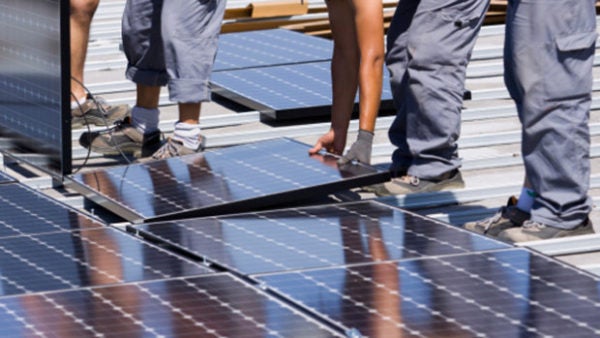How microgrids and renewable energy can spark an energy rebirth in Puerto Rico

The devastation wrought by Hurricane Maria demonstrated the weaknesses of Puerto Rico’s centralized and fossil fuel-dominated energy infrastructure. In the wake of this disaster, there is hope the island’s energy system can be remade so that it is more reliable, resilient, and cleaner than before. In order for this to happen, it will be necessary to rethink more than just wires and hardware. Institutions on and off the island need to change the way they do business.
The Puerto Rico Electric Power Authority (PREPA) is responsible for generating electricity for all Puerto Rican residents. As a public utility, PREPA produces, transmits, distributes and sells electricity. As a government corporation, it is empowered to make contracts, acquire properties, borrow money and issue bonds. PREPA also establishes rate structures for its services. These rates are subject to approval by the Puerto Rico Energy Commission (PREC). The corporation is run by a nine-member governing board. The board consists of six people appointed by the governor, the Secretary of the Department of Transportation and Public Works, and two members elected by its energy consumers.
“The current structures are not working,” said Cathy Kunkel of The Institute for Energy Economics and Financial Analysis (IEEFA). “There needs to be fundamental reform of PREPA, which has suffered for decades from highly politicized upper management and lack of public accountability.” IEEFA is one organization that has strongly advocated for a structural and organizational reboot for Puerto Rico’s energy system. Kunkel predicts that with the introduction of new technology, including microgrids, more and more energy consumers will take on the role of producers, and will also take a more active role in the grid. Microgrids are small generation and distribution systems that can be operated separately from the main grid.
IEEFA believes that microgrids ought to be part of any proper transition. Puerto Rico relies almost exclusively on fossil fuels. Electricity generation is centered mostly in the southern part of the island. This means long transmission lines are necessary to transport this energy to northern communities, making them vulnerable to blackouts or disruption.
PREC was formed in 2014 in part to deal with the very low level of renewable energy that had thus far been produced in Puerto Rico. This webpage contains a 2013 chart showing renewable energy at only a little over one percent of the total for the island, and nearly all of that one percent, as this article points out, was from hydroelectricity.
In November of last year, the commission published a request for comment on best practices in microgrid and distributed generation development. Only two months later, it proposed new rules on establishing microgrids in Puerto Rico. These rules define the kinds of microgrid permissible as “renewable, combined heat and power, or a hybrid of the two. Diesel use is allowed, but limited.” The proposed rules also allow for a broad range of ownership models, including cooperatives, municipalities, nonprofits and others.
According to Kunkel, the new rules were badly needed. Despite the enormous recent interest in privately-owned microgrids, there was a “lack of regulatory clarity” about them. Among the questions that had yet to be answered were: who can develop and own them? How much can they charge? What should be the qualifications of microgrid developers?
“[PREC] is doing exactly what it should be doing: responding to the changing conditions on the island (the need to rebuild and the potential new resources available) and issuing the necessary regulations that can help with the transformation of the energy system,” Kunkel said.
One of the main obstacles to microgrid development in Puerto Rico, however, is the utility, PREPA, itself. “PREPA has historically been committed to fossil fuels and dismissive of renewable energy development,” Kunkel said. She pointed out that although a law had imposed on the utility the goal of generating at least twelve percent renewable energy on the island by 2015, by that date only two percent of the island’s energy came from renewable sources.
The U.S. Energy Information Agency found that in 2016, Puerto Rico generated 47 percent of its energy from petroleum. By comparison, on the mainland oil has accounted for less than one-half of one percent of energy production. Since all of that oil has to be imported into resource-poor Puerto Rico, it’s not surprising that the island’s electricity cost per kilowatt/hour is just over 25 cents. This is about twice the average for the U.S. mainland.
PREPA is not the only organizational barrier to developing a better electric delivery system for renewables in Puerto Rico. The federal Financial Oversight and Management Board (FOMB) was created in 2016 to manage Puerto Rico’s debt restructuring. It recently put forward for public comment four new proposed energy projects. Kunkel believes these projects – which include a garbage incinerator and new oil/natural gas dual fuel units – are at odds with PREC’s vision for the system’s distributed renewable future. FOMB did not even follow proper procedure in its proposal: the Board should have first sent it to the Commission for review. The purpose of this review would have been to determine whether the FOMB’s proposal is in accord with the commission’s Integrated Resource Plan (IRP). The IRP is a document that lays out PREC vision for developments to Puerto Rico’s electric system.
“If [PREC] is allowed to do its job, it will come up with good regulations that could be a model for mainland U.S. states,” Kunkel said. “The economics for microgrids are stronger in Puerto Rico than in most states because retail electric rates are so high, so, in theory, Puerto Rico has the potential to become a leader and innovator in deployment of reliable, decentralized energy technologies.”
